Top 10 Google Ads Mistakes in 2025 and How to Avoid Them
You’ve spent hours building your campaign, carefully picking your keywords, and crafting the perfect ad copy. But when the results roll in, they’re… underwhelming. Sound familiar? You’re not alone. Many businesses pour thousands into paid ads only to see minimal returns, often because of overlooked yet common Google Ads mistakes.
In fact, according to a recent report by WordStream, over 50% of Google Ads budgets are wasted due to poor targeting and mismanaged settings.
In 2025, running successful campaigns is more complex than ever. With algorithm updates, AI-driven automation, and evolving user behaviors, even seasoned marketers can fall behind. The rules of the game are shifting, and staying static means falling short or worse, falling behind your competitors.
That’s why we’ve put together this guide to spotlight the top 10 Google Ads mistakes in 2025 and how to sidestep them. Whether you’re a small business owner or a digital strategist, these tips will help you optimize performance, boost ROI, and avoid costly blunders.
Understanding the Basics of Google Ads
Before we dive into the common pitfalls, it’s essential to understand the basics of Google Ads. This platform, formerly known as Google AdWords, allows businesses to pay for ads that appear in search results, on websites, and even on YouTube.
To succeed, you need to create compelling ads, choose the right keywords, and set smart bids—all to drive targeted traffic and boost your online visibility.
What Are Google Ads?
Google Ads is Google’s online advertising platform that lets businesses create and run ads across Google Search and its extensive network of partner websites. Advertisers bid on keywords related to their products or services, and their ads appear when users search for those terms. It’s a powerful way to reach potential customers at the exact moment they’re looking for what you offer.
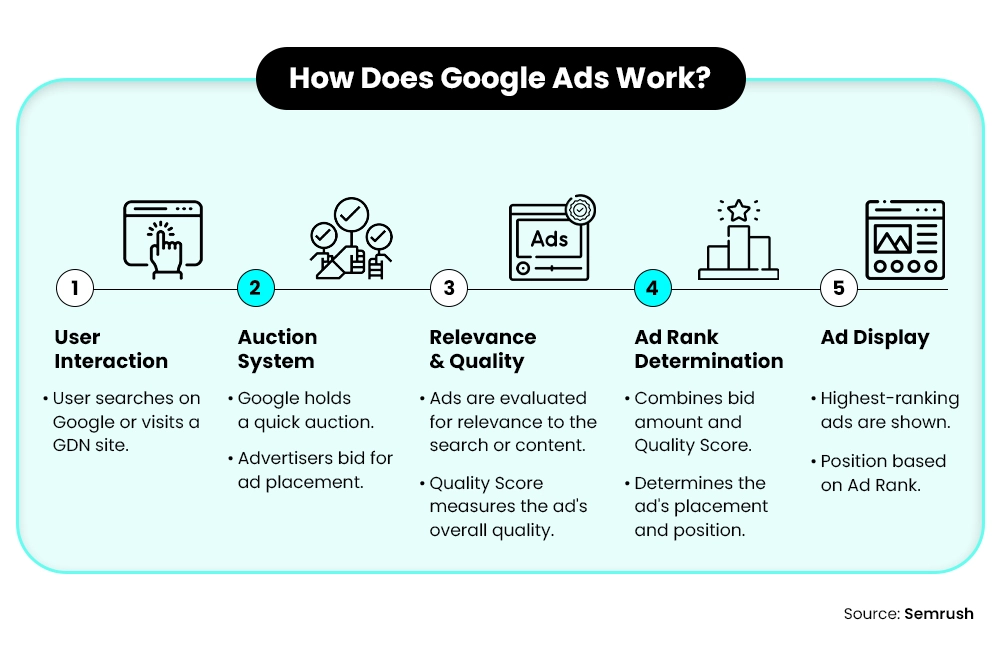
The Evolving Landscape of Google Ads in 2025
If you’re running paid campaigns this year, you’ve probably noticed how fast things are changing. From AI-powered bidding strategies to tighter privacy regulations and new ad formats, 2025 is reshaping how we approach Google Ads. These shifts, while powerful, also open the door to a whole new set of Google Ads mistakes to avoid, or worse, they amplify the ones advertisers have been making for years.
Increased automation sounds like a dream, but without proper oversight, it can lead to wasted budgets and missed opportunities. Add to that evolving user behavior and restrictions on data tracking, and it’s clear: what worked last year might not work today.
That’s why staying adaptable isn’t just smart—it’s necessary. Understanding these changes and proactively optimizing your campaigns is the only way to stay ahead.
The Importance of Keyword Research
Keyword research is a vital part of any successful Google Ads campaign. It helps you understand what your target audience is searching for, so your ads appear in front of the right people at the right time. Skipping this step can lead to wasted budget and poor results.
Effective keyword research goes beyond just finding high-volume terms; it’s about understanding user intent. When you align your keywords with what people seek, you can craft more relevant ad copy and landing pages. This not only improves click-through rates but also drives better conversions and overall campaign performance.
The Role of Ad Groups in Google Ads
Ad groups play a key role in organizing your Google Ads campaigns effectively. Each ad group should center around a specific theme, product, or service, allowing you to create tightly focused ads that speak directly to your audience’s intent. Poorly structured ad groups often lead to mismatched messaging and lower click-through rates.
To get the most out of your campaigns, group closely related keywords within each ad group and write ad copy that directly aligns with those terms. This not only boosts your ad relevance but also improves your Quality Score—Google’s measure of ad performance. A higher Quality Score can lead to better ad placements and lower costs per click, ultimately improving your overall campaign results.
– Also Read- Meta Ads and Google Ads: How They Work Together in Cross-Platform Strategies?
10 Common Mistakes in Google Ads
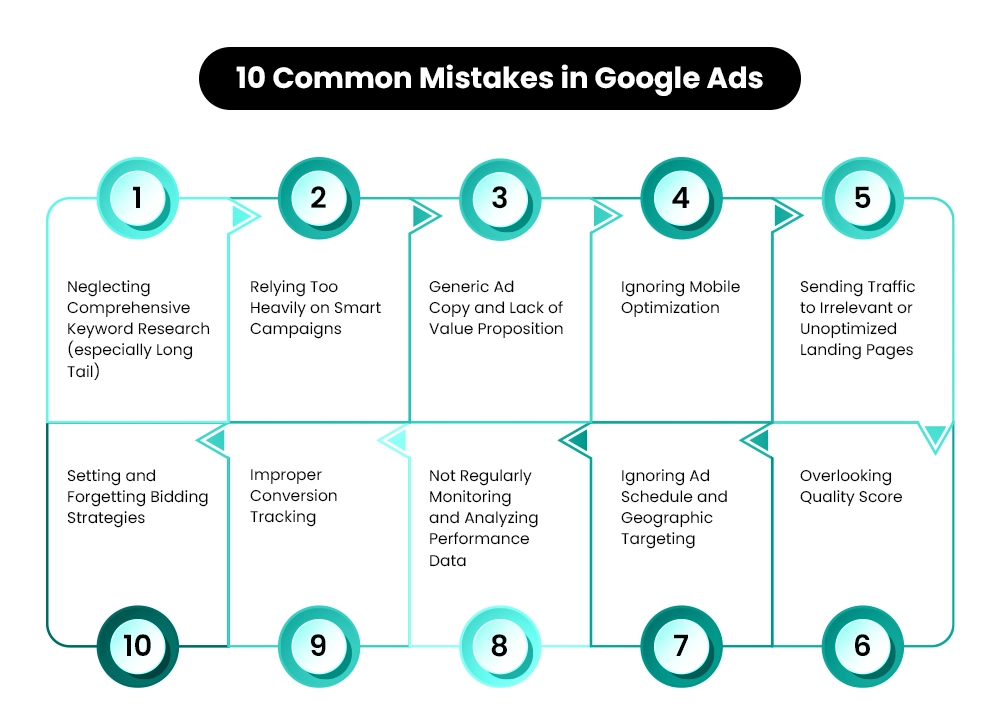
Let’s drive into the common Google ads mistakes to avoid when running the PPC campaign or Google ads campaigns.
1. Neglecting Comprehensive Keyword Research (especially Long-Tail)
One of the most common mistakes to avoid in Google Ads is neglecting deep keyword research, especially long-tail keywords. Many advertisers rely too heavily on broad match keywords, which can trigger ads for irrelevant searches, leading to wasted budget and poor targeting.
By skipping long-tail keywords, you miss out on:
- Highly targeted, niche search terms.
- Lower competition keywords with better ROI.
- Users are further along in the buying journey, ready to convert.
How to Avoid It:
- Use tools like Google Keyword Planner, SEMrush, or Ahrefs to discover new opportunities.
- Focus on user intent—informational, navigational, or transactional.
- Explore and prioritize long-tail keywords for precise targeting.
- Regularly check your search terms report to:
- Identify new keyword ideas.
- Add irrelevant terms as negative keywords.
Effective keyword strategy isn’t about casting the widest net—it’s about reaching the right people at the right time.
– Also Read- Say NO to Keyword Stuffing with Google’s Information Gain
2. Relying Too Heavily on Smart Campaigns
One of the more subtle Google ad campaign mistakes in 2025 is depending too much on Smart Campaigns. While they sound appealing—automated setup, easy management, and less time spent tweaking—Smart Campaigns often offer limited control over targeting, bidding, and keyword selection.
This can lead to poor ad placement, wasted budget, and underwhelming performance, especially for businesses with specific goals or niche audiences.
Smart Campaigns can work for very small businesses or beginners, but they’re not ideal for advertisers who want to scale or fine-tune performance.
How to Avoid It:
- Switch to Expert Mode in your Google Ads account to unlock full control over campaigns.
- Customize targeting, bidding strategies, ad copy, and keyword selection.
- Use data-driven insights to adjust and optimize your campaigns regularly.
- A/B test different ad sets to see which performs best.
By taking more control and moving beyond Smart Campaigns, you’ll have a much better shot at running efficient, high-ROI campaigns tailored to your goals.
– Also Read- How to Choose and Test SEM Bidding Strategies to Improve Your Bid Management
3. Generic Ad Copy and Lack of Value Proposition
One of the most overlooked Google Ads mistakes is writing generic ad copy that fails to grab attention or connect with the audience. If your ad looks like everyone else’s—no clear benefit, no emotion, no hook it’s likely to get ignored.
This kind of copy doesn’t address the user’s pain points or explain why they should choose you over a competitor, leading to wasted ad spend and low click-through rates. Your ad copy needs to do more than just say what you offer; it needs to sell it.
How to Avoid It:
- Highlight your unique selling propositions (USPs), which set your business apart.
- Use strong, action-oriented calls to action (CTAs).
- Speak directly to the user’s needs, questions, or problems.
- Add ad extensions like sitelinks, callouts, and structured snippets to provide more info and boost visibility.
- A/B test different versions of your ad copy to see what resonates best.
Great ad copy isn’t just about writing—it’s about knowing your audience and delivering the right message at the right moment.
– Also Read- 5 Tips For Writing Compelling Ad Copy That Converts [With Examples]
4. Ignoring Mobile Optimization
With most users now browsing and shopping from their phones, skipping mobile optimization can seriously hurt your digital marketing performance. A clunky mobile experience—slow loading times, hard-to-read text, or confusing navigation can cause users to bounce before they even consider your offer. Even if your ads are getting clicks, poor mobile usability can crush your conversion rates.
Today’s consumers expect fast, seamless mobile experiences. If your landing pages or ads aren’t built with mobile in mind, you’re likely leaving money on the table.
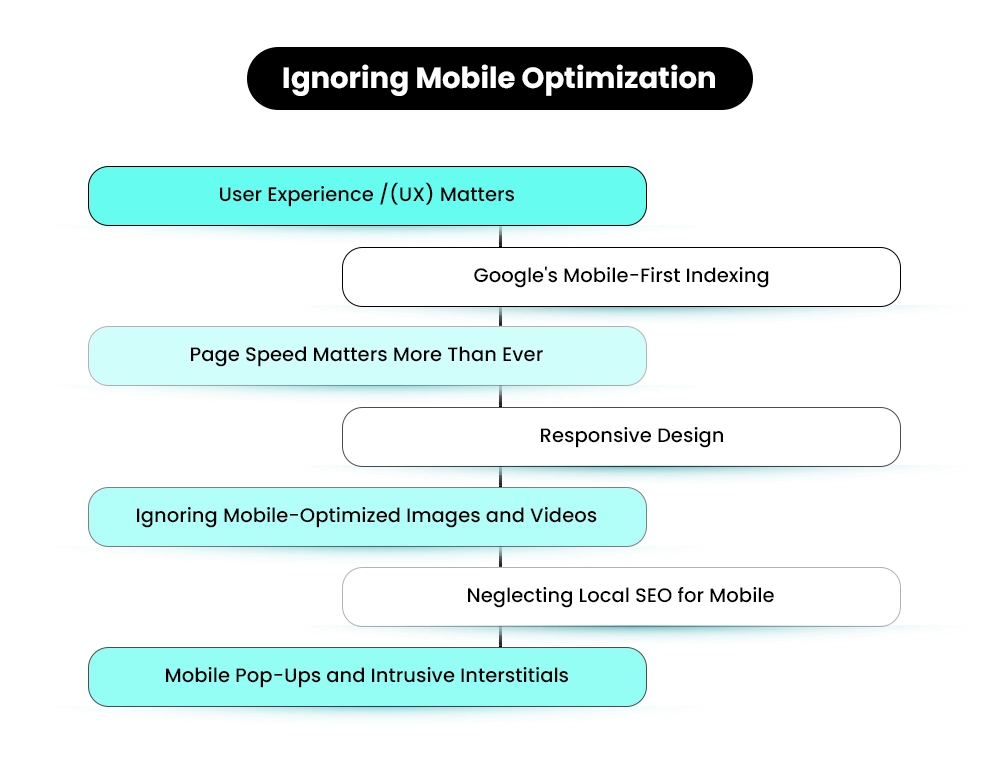
How to Avoid It:
- Use responsive search ads that adjust to different screen sizes and formats.
- Make sure your landing pages load quickly and are mobile-friendly.
- Keep copy clear, buttons clickable, and forms easy to fill out on smaller screens.
- Regularly test your ads and pages on different devices to catch any issues.
- Use Google’s Mobile-Friendly Test to spot problem areas.
Optimizing for mobile isn’t optional anymore—it’s essential for driving results and making the most of your ad budget.
5. Sending Traffic to Irrelevant or Unoptimized Landing Pages
Driving traffic through ads is only half the job; where that traffic lands makes all the difference. A major source of wasted budget and Google Ads mistakes comes from sending users to landing pages that don’t align with the ad message or search intent.
This disconnect often results in high bounce rates, low engagement, and poor conversion tracking. When users click an ad expecting one thing and land on a page offering something else (or nothing clear at all), they leave. Fast.
How to Avoid It:
- Make sure your landing page content matches your ad copy and the keywords you’re targeting.
- Tailor pages to the user’s intent—informational, transactional, or navigational.
- Optimize pages for mobile responsiveness so they look and function great on all devices.
- Prioritize fast loading speeds—a delay of even a few seconds can kill conversions.
- Use clear calls to action (CTAs) and make it easy for users to take the next step.
When your ad and landing page work together seamlessly, users are more likely to stay, engage, and convert.
6. Setting and Forgetting Bidding Strategies
Letting your campaign run on autopilot with default bidding strategies can quickly lead to wasted budget and missed opportunities. If you’re not actively managing your bids, you may be overpaying for low-performing keywords or underbidding on high-converting ones. The key to success lies in using data-driven decisions to guide your approach.
To stay competitive, you need to regularly analyze campaign performance and make strategic adjustments.
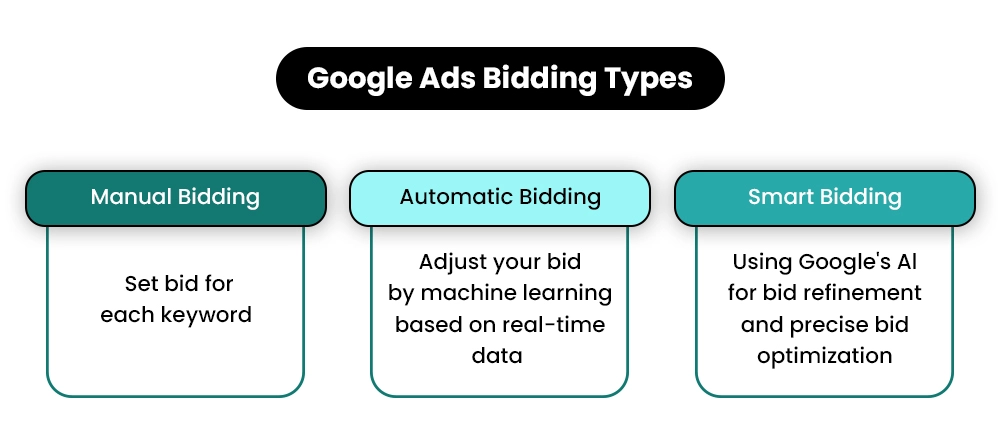
How to Avoid It:
- Learn the differences between bidding options like Maximize Conversions, Target CPA, and Enhanced CPC.
- Choose the strategy that aligns best with your campaign goals and budget.
- Monitor performance metrics such as conversion rates and cost per conversion to adjust bids as needed.
- Test smart bidding strategies, but keep a close eye on results and tweak settings as necessary.
As part of your broader strategies to identify and avoid Google Ads mistakes, consistent bid optimization ensures your campaigns remain competitive and cost-effective, maximizing ROI without leaving success up to chance.
7. Improper Conversion Tracking
If you’re not tracking conversions properly, you’re flying blind with your campaigns. This is one of those Google Ads mistakes that quietly drains your budget and skews decision-making. Without accurate conversion data, it’s nearly impossible to know which ads, keywords, or audiences are driving results.
Relying on guesswork instead of data means you might keep investing in underperforming tactics, hurting your Google Ads performance and ROI over time.
How to Avoid It:
- Set up Google Analytics 4 (GA4) integrated with Google Tag Manager (GTM).
- Define clear KPIs—purchases, form submissions, downloads, etc.—and create events that reflect real business goals.
- Regularly test your tracking setup to ensure it’s firing correctly across all devices.
- Use enhanced conversions to improve accuracy, especially in a cookieless world.
- Choose an appropriate attribution model (data-driven is a great start) to evaluate ad impact fairly.
When your conversion tracking is dialed in, you gain the insights needed to optimize smartly and grow your campaign’s true potential.
8. Not Regularly Monitoring and Analyzing Performance Data
Letting your Google Ads campaigns run without regular check-ins is like driving without a dashboard; you’re bound to miss warning signs. Among the most damaging Google Ads mistakes is ignoring performance data that could help you spot underperforming ads, rising costs, or conversion issues early on.
Staying data-driven is what separates successful advertisers from those who burn through their budget without results.
How to Avoid It:
- Set a clear schedule to review reports—daily for spend spikes, weekly for trends, and monthly for strategy reviews.
- Pay close attention to key metrics like click-through rate (CTR), conversion rates, cost per acquisition (CPA), and return on ad spend (ROAS).
- Use tools like Google Ads’ built-in reports, GA4, and custom dashboards to keep tabs on performance.
- Be ready to depend, pause low-performing ads, shift budget, or adjust targeting based on your findings.
Regular analysis not only keeps your campaigns in check but also ensures you’re constantly optimizing for better performance and ROI.
– Also Read- SEO vs PPC Advertising: Which One Is Better for Beginners?
9. Ignoring Ad Schedule and Geographic Targeting
If you’re not paying attention to when and where you show your ads, you could be wasting a big chunk of your budget. A major mistake to avoid in Google Ads is running campaigns 24/7 across all locations without checking if those times or places deliver results.
Not all hours or regions bring the same value; ignoring that can hurt your ad spend.
How to Avoid It:
- Use performance data to analyze which hours and days deliver the best results.
- Set adjustments to increase or decrease bids during high or low-performing time slots.
- Focus your geographic targeting on regions where your ideal customers are located.
- Exclude locations that consistently underperform or bring irrelevant traffic.
- Use location-based messaging to make your ads more relevant.
Optimizing your ad schedule and geography settings ensures you’re only spending money where it makes sense, maximizing your ROI, and reaching the right audience at the right time.
10. Overlooking Quality Score
Running ads without keeping an eye on your quality score can lead to unnecessarily high costs. This metric directly impacts how much you pay per click (CPC) and where your ads show up on the search results page.
If your score is low, even a big budget won’t guarantee top placement. It’s one of those Google Ads mistakes that quietly drains your ad spend over time.
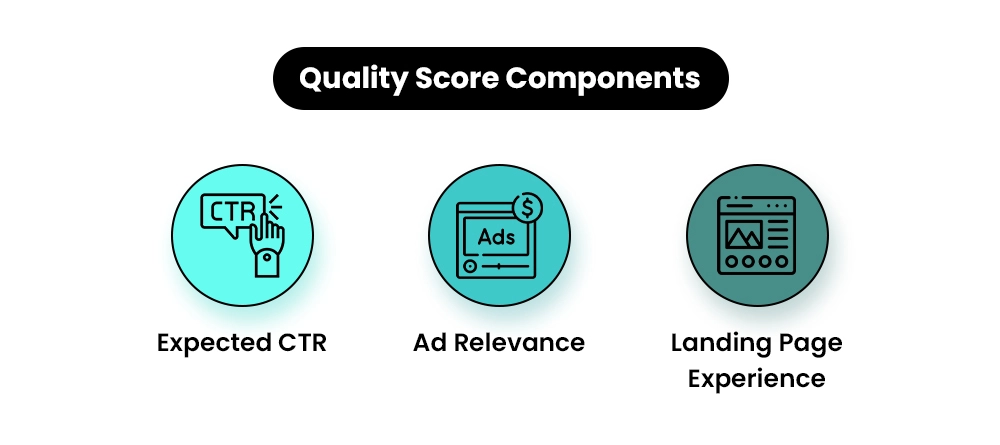
How to Avoid It:
- Write highly relevant ad copy that matches your target keywords.
- Make sure your landing page provides a smooth, useful experience that aligns with your ad’s promise.
- Work on boosting your click-through rate (CTR) by using strong headlines and compelling CTAs.
- Continuously test different ad versions to find what resonates best with your audience.
- Monitor your quality score regularly through your Google Ads dashboard.
A higher quality score not only reduces your cost-per-click but also improves your ad rankings, helping you get more out of your budget with better results.
Conclusion
Avoiding Google Ads mistakes isn’t about being perfect; it’s about staying informed, intentional, and ready to adapt. As the platform continues to evolve in 2025, marketers who pay attention to data, user intent, and campaign structure will consistently outperform those who “set and forget.”
Whether it’s tracking conversions accurately, writing better ad copy, or refining your targeting, every small adjustment adds up to smarter spending and stronger results. Keep testing, learning, and optimizing because the success of your campaigns depends on more than just budget; it depends on how well you execute.
Ready to get more from your ad spend? Start by avoiding these common missteps and building a strategy with Mastroke that works smarter, not harder.
FAQs-
1. What are the most common Google Ads mistakes in 2025?
In 2025, common Google Ads mistakes include over-relying on automation, ignoring keyword intent, skipping mobile optimization, poor conversion tracking, and using generic ad copy. Many advertisers also neglect data analysis and audience targeting, leading to wasted budget and underperforming campaigns.
2. How do I avoid wasting money on Google Ads?
To avoid wasting money, define clear goals, use proper keyword match types, optimize landing pages, and track conversions accurately. Avoid “set it and forget it” campaigns—regularly review data, adjust bids, test ad variations, and refine targeting based on performance insights.
3. What’s the best way to improve Google Ads performance in 2025?
Improving Google Ads performance in 2025 means being data-driven. Focus on high-intent keywords, compelling ad copy, optimized landing pages, and strategic bidding. Use GA4 and Google Ads tools for tracking, and consistently test and tweak campaigns to stay aligned with your goals and audience behavior.